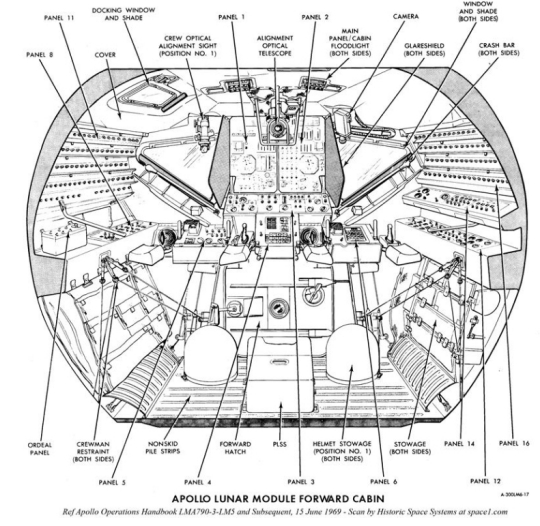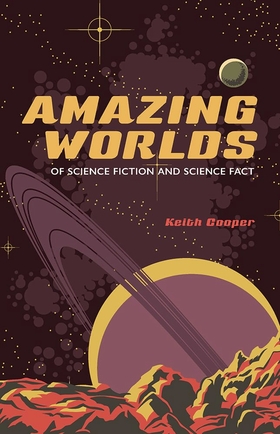Centauri Dreams
Imagining and Planning Interstellar Exploration
VERITAS: Strengthening the Optical SETI Search
Breakthrough Listen has just announced a new optical SETI effort in partnership with the VERITAS Collaboration. The news took me by surprise, for VERITAS (Very Energetic Radiation Imaging Telescope Array System) generally deals in high-energy astrophysics, with a focus on gamma rays, which signal their presence through flashes of Cherenkov radiation when they strike the Earth’s atmosphere. Here, the array is being used to look for technosignatures, as Andrew Siemion (UC- Berkeley SETI Research Center) explains:
“Breakthrough Listen is already the most powerful, comprehensive, and intensive search yet undertaken for signs of intelligent life beyond Earth. Now, with the addition of VERITAS, we’re sensitive to an important new class of signals: fast optical pulses. Optical communication has already been used by NASA to transmit high definition images to Earth from the Moon, so there’s reason to believe that an advanced civilization might use a scaled-up version of this technology for interstellar communication.”

Image: View of the Fred Lawrence Whipple Observatory basecamp and the VERITAS array. Credit: VERITAS.
So the search for faint optical flashes that could signal the presence of an extraterrestrial civilization deepens, complementing the optical SETI work currently underway at Breakthrough Listen as well as its ongoing survey at radio frequencies. VERITAS brings four 12-meter telescopes located at the basecamp of the Fred Lawrence Whipple Observatory on Mount Hopkins in Arizona into the mix. This is quite an exoplanet venue: The observatory has facilities at different elevations, including exoplanet arrays for HAT (Hungarian-made Automated Telescope), the MEarth project and MINERVA, all three of these robotic.
In the Breakthrough Listen effort, VERITAS will be looking for pulsed optical beacons with durations as short as several nanoseconds, for at timescales like these, an artificial beacon could outshine any stars located in the same region of sky. All four telescopes will be used simultaneously, which should assist the effort in screening out false positive detections.
Although I hadn’t realized it until looking further into VERITAS, the array has already seen use in a search of Boyajian’s Star for such pulses (see Abeysekara et al., “A Search for Brief Optical Flashes Associated with the SETI Target KIC 8462852,” abstract here). You’ll recall that this star has received intense scrutiny because of its unusual pattern of dimming, which did not correspond to planetary transits and raised questions about the source of the lightcurve variations.
Now VERITAS goes to work on stars not already found on Breakthrough Listen’s primary star list. The numbers are striking: Breakthrough Listen calculates that if a laser delivering 500 terawatts in a pulse lasting a few nanoseconds were located at the same distance as Boyajian’s Star (an F3V-class object in Cygnus approximately 1470 light years away) and pointed in our direction, VERITAS would be able to detect it.
Most stars in the Breakthrough Listen target list, however, are considerably closer. Hence the VERITAS search will be sensitive to pulses a factor 100 – 10,000 times fainter still. Thus an array built with the purpose of studying very-high-energy gamma rays proves adaptable to a search for technosignatures, with UC-Santa Cruz physicist David Williams, one of the effort’s leaders, saying “It is impressive how well-suited the VERITAS telescopes are for this project.” Williams will work in collaboration with Jamie Holder (University of Delaware) and Andrew Siemion’s Breakthrough Listen team at UC-Berkeley’s SETI Research Center (BSRC).
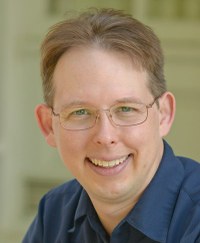
While we’re on the topic of SETI, let me also call your attention to a new resource that Penn State’s Jason Wright and Alan Reyes have created. Go to the NASA ADS site and include in your search terms ‘bibgroup:SETI’. I just searched, for example, using ‘author:”maccone” bibgroup:SETI’ and came up with 56 hits. SETI has been short on bibliographical resources, so this is promising stuff. You’ll need to familiarize yourself with the search syntax, but it’s not at all difficult, and will reward those looking to firm up a citation or check on the status of a particular scientist’s work. Wright and Reyes have submitted a paper on the bibliography to JBIS. For more, see Towards a Comprehensive Bibliography for SETI.
Image: Penn State’s Jason Wright. Credit: PSU.

Sail Deployment: Reflections on LightSail 2
One thing that James E. Webb insisted on during his tenure as NASA administrator was that the space program was larger than an attempt to get humans to the Moon. The man who did so much to ensure that Apollo would succeed, and who will be rightfully honored in the form of the James Webb Space Telescope, was a proponent of exploration throughout the Solar System through robotic craft, and weather and communications satellites that would become part of a permanent reliance on a growing space infrastructure. Marc Millis noted some of the results in his recent essay.
For while the frustration of abandoning the Moon in the 1970s lingers, we do have over 4600 spacecraft in Earth orbit, many of them doing the kind of work Webb envisioned. We’ve completed the initial reconnaissance of the Solar System and made our first tentative ventures into the Kuiper Belt and out past the heliopause. We’re charting exoplanets and looking to explore Saturn’s largest moon. So these are things to keep in mind when frustration begins to build.
The anniversary of Apollo’s first landing was a time for looking back, but The Planetary Society has just reminded us that we have to keep looking ahead as well. With the successful deployment of the solar sail aboard LightSail 2, we are seeing the kind of change Millis talked about in action. Much of the space business has turned commercial, while we continue to sort out how to handle the change (SLS or Falcon Heavy?), and in the midst of this, private organizations using off-the-shelf hardware can produce crowd-funded missions of real value.
SAIL DEPLOYMENT COMPLETE! We're sailing on SUNLIGHT!!!!! pic.twitter.com/PA74NMa7Ry
— Planetary Society (@exploreplanets) July 23, 2019
We’re in that confusing time — one that future historians will be able to sort out more readily than we can define it today — when the pace of technological change drives new models for the accomplishment of grand goals. How we interrelate big government projects with corporate space activities and private contributions will define an era that will one day have its own name, just as the 1960s could be partially defined by the term ‘Space Race.’ And it’s understandable that Planetary Society CEO Bill Nye should be proud of what his organization has accomplished: “We are advancing space science and exploration,” says Nye. “We are democratizing space. We are innovating.”
Apollo 8 gave us gorgeous photographs of our planet seen entire, a blue and brown crystal filling the frame. Now we have LightSail 2’s view of Earth, showing vast portions of the Pacific Ocean and part of the North American landmass. CubeSats in their various configurations make it possible for organizations like The Planetary Society as well as universities and other private groups to contemplate missions that move the ball forward. In the case of LightSail 2, we will have learned more about sail deployment, and orbit raising by the pressure of sunlight alone.
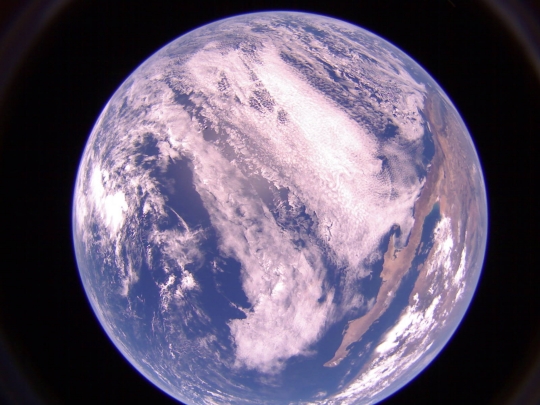
Image: This image of Earth, which shows the Pacific Ocean with Baja California and Mexico on the right, was captured by LightSail 2 on 18 July 2019 at 21:45 UTC while the spacecraft was in range of its ground station at Cal Poly San Luis Obispo in California. Though LightSail 2’s altitude is only 720 kilometers, its 185-degree, wide-angle camera lenses allow it to capture horizon-to-horizon Earth imagery. Credit: The Planetary Society.
The deployment command to LightSail 2 went out at about 1445 EDT (1845 UTC) on the 23rd, with the momentum wheel, responsible for orienting the sail in relation to the Sun, spinning up successfully. Now we wait for images of the deployed sail, which should be downloaded today.
Here’s a photo of the LightSail 2 team set up for sail deployment. It’s impossible to ignore the contrast between the Mission Control operations we see at NASA (think of the operation Chris Kraft ran!) and the ad hoc effort at Cal Poly. What makes this possible is vision, public financial support and technology trends working in favor of small, light spacecraft, not to mention gritty persistence. I’ll feel better when I’ve seen actual sail images, but for right now, things look good, and the entire Planetary Society team deserves our congratulations.
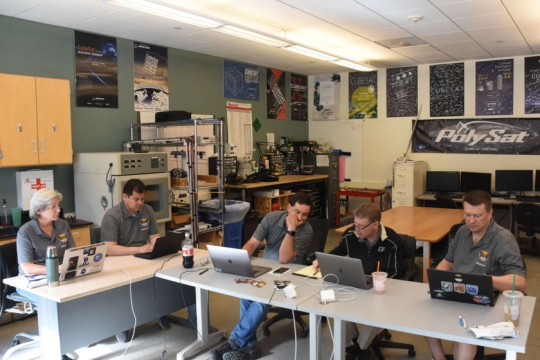
Image: This image shows The Planetary Society’s LightSail 2 team on console prior to sail deployment on 23 July 2019 at the Cal Poly CubeSat lab in San Luis Obispo, California. From left: Barbara Plante, Founder and President, Boreal Space; Alex Diaz, Avionics Engineer, Ecliptic Enterprises Corporation; John Bellardo, Associate Professor, Cal Poly San Luis Obispo; Dave Spencer, LightSail Project Manager, Associate Professor at Purdue University; Bruce Betts, LightSail Program Manager, Planetary Society Chief Scientist. Credit: The Planetary Society.
You can track LightSail 2’s condition on its own Mission Control page, which offers data on temperature, degree of rotation, control mode and location over the Earth. 40,000 private donations (totalling in the region of $7 million) went into LightSail 2 over 10 years. The results of the effort will also feed a NASA project called Near Earth Asteroid Scout, which will likewise employ CubeSat technology to visit an asteroid early in the 2020s. Launched by a Falcon Heavy, LightSail 2 emphasizes today’s mix of commercial, corporate and private effort.
I fall back on what Marc Millis said in these pages on Monday:
It is my hope that progress will continue along all these fronts and improve the human condition. The next steps toward the Moon, Mars and recreational spaceflight will usher in a new era, a suitable name for which will probably be conceived years later. It’s certainly no longer a “space race” with only one finish line. It is the beginning of a new stage of humanity.

Remembering Chris Kraft
As a poignant and unexpected coda to the celebrations of the Apollo 11 anniversary we learn of the death of Chris Kraft, the man who created NASA’s Mission Control from scratch in the early days of the manned space program and was head of Flight Operations during that critical period. Death came at age 95 to a man who worked at ground zero in the fraught days of Mercury and Gemini, serving as flight director for all the Mercury missions and seven of the Gemini flights. Neil Armstrong would say of Kraft that he was “the ‘Control’ in Mission Control.”
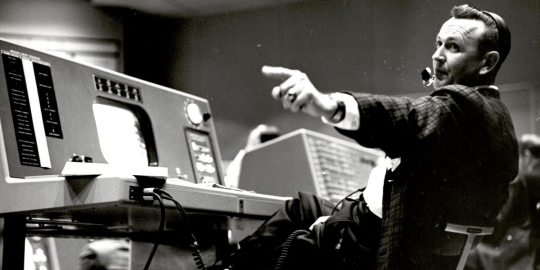
Image: Christopher Kraft, flight director during Project Mercury, works at his console inside the Flight Control area at Mercury Mission Control in Houston. Kraft, the founder of NASA’s Mission Control, died Monday, July 22, 2019, just two days after the 50th anniversary of the Apollo 11 moon landing. He was 95. Credit: NASA via AP.
After his work with Gemini, Kraft moved up NASA management ranks and became a senior planner for the Apollo program. He went on to lead the Johnson Space Center in Houston and was deeply involved in the Space Shuttle program, though for many of us, he will always be the voice we heard in TV coverage of missions dating back to Alan Shepard’s suborbital shot in 1961, a mission during which he later admitted he was ‘shaking like a leaf’ (it certainly never showed, and Kraft added that his nerves steadied considerably after the Shepard flight).
The challenge presented to Kraft was immense, coordinating the inputs from the dozens of controllers who tracked spacecraft operations while balancing teams of researchers and engineers in an environment that could demand quick, decisive action to save a mission. Go to Houston today and you’ll see that Mission Control Center at JSC is named after Kraft, whose legacy is not just a room of controllers but the very concept of flight management still in use.
Al Jackson, who knew Kraft through his work on the Lunar Module Simulator, wrote this morning with his own recollection of the man, calling Kraft ‘the best technical manager I ever met,’ and adding:
The training simulator group rarely had to meet with him, but every now and then the crews would want some kind of modification to the simulators, so we would go to his office. I always liked those meeting because they were short! The problem would be presented and Kraft, once it was clear to him, would make the decision on what to do. There was no extra talk; he just said “you will do this and this and this”… and the meeting was over usually in less than 30 minutes. I have never met another technical manager like him. He was an exceptional man.
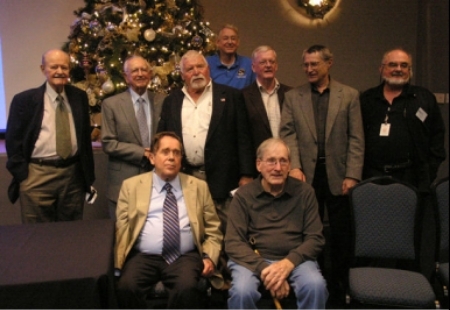
Image: A 40th anniversary panel on Apollo 8 organized by Al Jackson in 2008. Left to right: Marty Jenness, Dr. Christopher Kraft, John Llewellyn, Dr. Glynn Lunney (with Ken Young behind him), Emil Shiesser, Al Jackson. Front row: Hal Beck, Rod Rose. Credit: Al Jackson.
Retiring in 1982, Kraft maintained an active interest in the space program as he pursued consulting options. This NPR article quotes him as he reflected on his career:
“I flew on every flight — vicariously. I didn’t have to go. I mean that. I used to tell people back then when we’re flying, I have this feeling that’s what we’re doing all the time. And then when we stop flying, I don’t believe we did it. That was a strange feeling. … I was in my revelry when we were flying. My people were the same way. It was such a tremendous pleasure out of making things happen well and safely and knowing that they were contributing to that part of the program. I think it was extremely important to all of us and that was our payoff. We didn’t make any money working for the government. But we sure got a hell of a lot of enjoyment out of it.”
This has been a summer of memories as we recalled the events leading to the Apollo landings. Playing through all of that history has been the steady and disciplined guidance provided by people like Chris Kraft, who were tasked with a job — going to the Moon! — that seemed insurmountable at a time when America’s experience in space was limited to a single 15-minute suborbital flight. There were truly giants in those days, and Chris Kraft was one of them.

From the Moon to the Stars
I’ll close my coverage of the Apollo 11 anniversary with thoughts from Marc Millis. I was startled to discover, fifty years after watching the first landing on the Moon, that the anniversary seemed almost elegiac. So many expectations that have yet to emerge, so much energy still waiting to find an Apollo-like focus. Marc has likewise been ruminating on the Moon landings and here offers a way of placing them in context. Such an effort invariably means invoking the long view, one I found challenging to sustain because of my own freighted memories of 20 July, 1969.
But I think Marc is right in looking for longer, more stable arcs of development and trends that the rush of daily activity can obscure. The former head of NASA’s Breakthrough Propulsion Physics project, Millis is also editor (with Eric Davis) of the book Frontiers of Propulsion Science (2009) and the founder of the Tau Zero Foundation. He has been developing an interstellar propulsion study from a NASA grant and recently returned from Europe, where he worked with Martin Tajmar’s SpaceDrive project at Germany’s Technische Universität Dresden.
by Marc G Millis
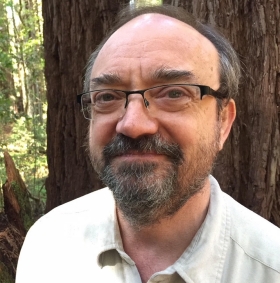
Anniversaries have a way of making us reflect. I was 9 years old during the first Moon walk. That event, and the steady progress that preceded it, profoundly affected me. Its power was more than just the amazing new technology and the mind-blowing fact that humanity was no longer constrained to this planet. I was also struck by how it affected the world.
For days following of the landing, the world was one. We were human beings sharing an amazing, peaceful, intellectual, human achievement. This achievement interrupted the usual gloomy news of war, social injustice, and the specter of imminent nuclear destruction. It showed us a side of humanity that made us feel good and cast hope for a better future. After centuries of humanity’s dreams about the Moon, we did it.
I broke out in tears when I recently heard the replay of the transmission: “Tranquility Base here. The Eagle has landed.” I recall, in that moment, how the future of humanity changed. All the way up to that point, we were not sure if touching the Moon was just fanciful wishing. After that point, it was fact. We knew, then, that humanity could accomplish great things – when we set our sights toward doing great things.
Instead of revisiting the real motivations for Apollo, I want to share the effect it had on an impressionable child. From my naive and idealistic 9-year-old view, I assumed that our national leaders had deliberately designed the Space Program as a catalyst for a sustainable modern Renaissance. I saw the Space Program as the grand challenge that would drive technological progress, extend prosperity and improve humanity. It gave the citizens a future they could look forward to. It gave us frontiers to conquer rather than the alternative of conquering each other.
On the individual level, it gave students a reason to excel in their studies and the prospect of meaningful careers – reasons to avoid drugs and debauchery. It made so much sense; healthy, exciting and positive. And the fact that the Moon landing was done as promised and on schedule – that fact made our national leaders look competent and trustworthy. Impressive stuff.
A year prior to the Moon landing, the movie 2001 a Space Odyssey showed us a vision of such a future. It included commercial shuttles taking passengers to an orbiting space station – complete with hotels and passport control. Moon bases not only existed, but there were several of them. The producers hired suitable aerospace professionals as consultants so that all of these things were envisioned plausibly – and it worked.
The dramatic contrast between the silence of space and the sound of breathing inside a spacesuit is etched in my memory. The portrayal of the difference between microgravity and artificial gravity (and vacuum and air) was convincing. The characters behaved in a manner consistent with their roles. The total effect is that 2001 cast an image of what the future could be, and based on the pace of the 60s Space Program, I expected it was the future that would be.
Fast-forward to now. Despite the painful demotion of the Space Race after Apollo into something more like a subdued slog, progress accumulated. A half century since Apollo, thirteen nations (or groups thereof) have space programs, including a few rich guys with their own launchers. Over 4600 spacecraft are in Earth orbit and about 150 farther beyond. Our satellites have saved countless lives with hurricane warnings, are keeping an eye on the health of our environment, and have enabled a level of world connectedness through communication that I hope fosters sustainable peace. We’ve seen planets and moons as never before. We’ve listened to the winds on Titan. And the tally of strange new worlds (exoplanets around other stars) has surpassed 4,000. One thing we still don’t know is if there is life beyond Earth.
Eclipsing nationalistic survival (and curiosity), the most common motive driving space development is now profit, where more than ¾ of space activities are commercial. Financial institutions have taken notice, seeing a market of $350 billion and growing. Bank of America Merrill Lynch sees the space industry reaching $2.7 trillion in 30 years. Combinations of government agencies and businesses – some collaborating, some competing – are embarking on Moon outposts with Mars as the sequel, plus the infrastructure to keep it all growing.
The scale of activity envisioned in 2001 might actually come to pass, but perhaps closer to 2041. It’s no longer a matter of “if it can be done,” but “when will it be fiscally prudent.” The age of rocket science, which was once just science fiction, has given way to engineering and business.
In the 1960s, when Moon missions were becoming reality, fiction about practical starflight emerged from science fiction magazines and novels into television and movies seen worldwide. Compiling ideas from decades before, Gene Roddenberry’s Star Trek put it all together in a positive future vision, where the incredible power of starships would be used by a responsibly mature society, where minorities and people from various cultures were included. In that future, you could explore strange new worlds, seek out new life and new civilizations. And once finding a new civilization, you could magically fix its silly social injustices in just a one-hour episode, while having time for romances with aliens. Inspiring stuff.
Moon missions were once derided as unrealistic fantasies at a time when the hot activity was advancing the emerging aircraft industry amidst two world wars. Of course, this does not mean that all science fiction will become real, but it does means that many of tomorrow’s realities appear impossible today. We just don’t know which of these are genuinely impossible and which suggest nothing more than an absence of imagination. This also means that pioneering work typically starts small, as minority efforts amid preoccupation with the era’s dominant activities.
Looking back to what made Apollo possible – that transition point when rocketry matured from art and fiction to become a science — that point was reached when Russian mathematician Konstantin Tsiolkovsky derived the “rocket equation.” Following its math, the scale of the challenge could be conceptualized and achieved. Coincidentally, this was the same year the Wright Brothers flew the first functional aircraft. In 1903, rocketry became a science, and air flight became engineering. A mere 66 years later, rocket science matured to engineering, and humans walked on the Moon. And now a half-century after the landing, spaceflight engineering has matured to business, and is on the verge of being available for recreation.

Image: Konstantin Tsiolkovsky, Russian pioneer in aeronautics and astronautics. Credit: Wikimedia Commons.
It is tempting to view interstellar pursuits in the same paradigm as the modern space industry, a sequence of expected and profitable next steps. While there is certainly some fertile ground in that notion, the complete challenge of practical starflight is at a much earlier stage, where it still benefits from thought-provoking science fiction and the pioneering science that precedes what can be engineered.
About three decades after Star Trek debuted, the fiction of faster-than-light (FTL) flight entered the sciences the same way rocketry did – with equations that revealed the scale of the challenge. Specifically, this fleshing out of the mathematics includes Morris-Thorne traversable wormholes (1988) and the Alcubierre warp drive (1994). Then came NASA’s Breakthrough Propulsion Physics project in 1995, which lasted until 2007 (though funding ended in 2002).
Instead of advancing technology within the limits of known physics, the NASA project sought further discoveries in physics to lay the foundations for new, breakthrough technologies. This inquiry encompassed the possibilities of FTL, non-rocket spacedrives, control of gravitation, and other related ambitions. A comparison of these ambitions to the lingering unknowns in physics was compiled in the 2009 book Frontiers of Propulsion Science. Its intent was to identify which research questions are attackable and relevant to these grander goals, showing the incremental steps that could begin today to chip away at the long string of unknowns.
Will the fiction of practical starflight eventually become reality? If I were clairvoyant, I could answer that question, but I’m not. What I do know is that, even if such ambitions turn out to be impossible, we will gain more in the attempt than by waxing pedantic or only working on what’s financially profitable.
It is my hope that progress will continue along all these fronts and improve the human condition. The next steps toward the Moon, Mars and recreational spaceflight will usher in a new era, a suitable name for which will probably be conceived years later. It’s certainly no longer a “space race” with only one finish line. It is the beginning of a new stage of humanity.
I also hope, amidst this ongoing activity, that we remember to support pioneering attempts to learn how to protect Earth’s habitability and take us to the stars even if they are not in the short run economically profitable.. And lastly, I hope that all these things will usher in a new Renaissance, if not by design, then by consequence, where the best aspects of the human character prevail to make our future not only sustainable, but also deeply exciting.
One closing thought. Idealism is one thing, but we must also consider the reality of human character. Progress in the 1960s was fueled by fear for survival and the urge to retain power, the most powerful motivations on the Maslow hierarchy of needs. The advances made while extinguishing those fears have now made it possible for people to personally profit from space, and even flaunt their status. In addition to commercial satellites, we’ve got rich guys creating their own space programs with a bit of “my rocket is bigger than your rocket” bravado.
I must confess that I thoroughly enjoy the swagger of throwing one’s shiny red sports car into space. Wherever humanity travels in the future, we will bring all of our human character with us, the good and the bad. It is my idealistic hope that, amid the self-serving motives that are fueling our current space age, we may also learn how to mobilize for the greater good.

Neil Armstrong: 2011 Speech in Australia
If a connection between accounting and astronautics seems tenuous, it’s one that Neil Armstrong invoked on the 24th of August, 2011, when he spoke before CPA Australia in Sydney, doubtless motivated by his father’s career as an auditor. Armstrong stopped signing autographs in 1996 and rarely spoke in public, but accepted the Sydney invitation, according to members of the audience, because of his declared ‘soft spot’ for accounting. While no video was allowed during the speech, author Neil McAleer has had access to an audio recording, though one of uneven quality. What follows is an excerpt from a longer project on the Moon landing that McAleer is working on, within which he adds commentary to the parts of the speech he was able to transcribe. Armstrong’s words throughout are in quotes, with McAleer’s additions in standard text. The first man on the Moon would die almost exactly one year after giving this speech.
“I am truly delighted to be here today and I thank you for the wonderful offer. And I thank the CPA for giving me an opportunity to play a part in this 125 anniversary gathering of your industry. . . .
“You might ask me, ‘how does it feel to be the oldest person in the room?’ [laughter] “Well, I ‘m not thrilled about it, but I am encouraged by old timers who did great things as senior citizens.
“Galileo invented one of his greatest discoveries at the age of 73. Edison was still inventing in his 80s. Toscanini was still conducting at 87. Titian, the famous Italian artist, painted the great battle of Lepanto at the age of 85.
“So, if there’s a need to find someone to command a starship for a tour around the Solar System, I am available. [Laughter and Applause]
“And if there’s anyone here tonight who is more senior than me, I apologize and congratulate you!”
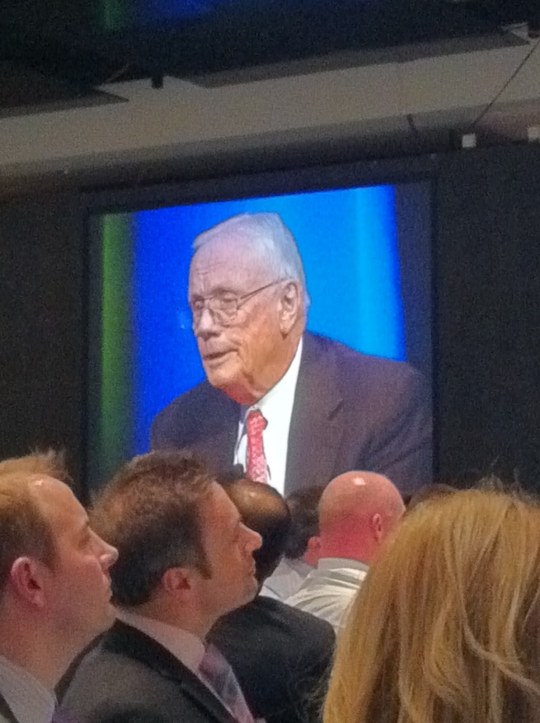
Image: Neil Armstrong speaking in Australia. Credit: Alan Kerlin.
Armstrong next talked about his father Stephen’s vocation, employed by the state of Ohio “to audit the books of its various county governments.” It involved a great deal of travel throughout the state.
“As a consequence of his job, he encountered the occasional embezzler, and eventually acquired the nickname of ‘Suicide Steve’.
“My father was a numbers guy and took great pride in his mastery of numerical precision. I shared this aptitude and affection for mathematics, which strongly influenced my educational career track toward engineering. Both careers are highly dependent on precision mathematics.”
An aptitude for math was certainly useful for a young boy who got his pilot’s license at age 16, who ultimately went on to serve as a fighter pilot in the Korean War, then a test pilot at Edwards Air Force Base, and then astronaut and commander of the first landing on the Moon—Apollo 11.
But throughout his life, Armstrong would always emphasize a personality trait that he believed was even more important than the technical skills needed in various professions. He quoted Calvin Coolidge.
“‘Nothing in this world can take the place of persistence: Talent will not; . . . Genius will not; . . . Education will not . . . Persistence and determination alone are omnipotent. Think about actress Elizabeth Taylor, for example. She was highly determined over many years in her search for the perfect husband.”
Neil’s next anecdote was a brief summary of a crisis between an accountant and his wife.
“A chief financial officer . . . is meeting with his accounting team for the purpose of finalizing and releasing their annual financial report. It is scheduled for a Saturday morning. The accountant’s wife has planned a special family luncheon to meet their daughter’s fiancé and his parents for a celebratory and get-acquainted lunch. ‘You must be home by 1:00 o’clock,’ ” his wife insisted.
“Well, what often happens, the annual meeting went on all morning and into the afternoon—the schedule had suffered because of some urgent issues that had to be addressed and resolved. The accountant got home very late —not just a little bit but a lot. The luncheon was long over and the guests had already left.
“His wife was more than distraught. She was crying! ‘I just can’t believe you,’ she sobbed. ‘You love accountants more than you love me!’
“The accountant didn’t know how to respond, but finally he replied: ‘I love you more than I love lawyers!'”
A story about domestic strife between an accountant and his wife moves to Armstrong’s thoughts of risk.
“Risk is a part of all our lives. There is no planned spaceflight mission that doesn’t carry potential risk. There is little progress without risk. In spaceflight we are genuinely dealing with the realities of risk. And increasingly today the popular business management curriculum has adopted risk management courses.
“Take as an example choosing the trajectory to travel from earth to the Moon . . . NASA selected a very particular route called ‘the free return trajectory.’ . . .”
This trajectory is one of the many decisions /actions taken by NASA to protect all its Apollo missions to the Moon from disaster, including the survival of the crippled Apollo 13 mission and the return of the crew safely to Earth. It was probably the most important safety feature of the entire Apollo Moon program—a pre-planned backup, save-the-mission strategy.
Although it never happened during an Apollo mission, if the programmed rockets didn’t fire or fired in error for the lunar orbit insertion maneuver (which had to succeed for a Moon-landing mission), the free return trajectory would use just the right amount of the Moon’s gravity to return the Apollo spacecraft safely to earth —avoiding an otherwise eternal voyage into the cosmos.
It is important to note that the explosion of the oxygen tank in the command module Odyssey (Apollo 13) occurred during one of the most benign parts of the mission as compared to the lunar orbit insertion rocket ignition. Had it happened then, or at other crucial times in the flight, the outcome could have been the loss of the spaceship and crew.
In reality, however, the crippled Apollo 13 spacecraft still needed a trajectory correction because of the impact of the oxygen tank explosion and other factors. This would insure the gravity of the Moon would successfully and accurately execute the free return trajectory. How would the maneuver be made? The creative answer from the crew and NASA experts back on earth was to use the fuel and engine of the undamaged (and unused!) Lunar Module, Aquarius, to correct the free return trajectory. This was the crew’s survival ticket back to earth.
Many people asked why NASA named their ill-fated April 1970 mission Apollo 13, said Armstrong. “After all, the number 13 is considered an unlucky number in much of the world. NASA answered that as an agency they are not superstitious but scientific and rational in all their program decisions.
“Nevertheless, NASA still says they are scientific, but they never did use the number 13 again to designate another spacecraft mission.” [Laughter]
Associated with the risk in our daily lives is the phrase ‘better than,’ and the common human motivation to lower risk and stress, raise our goals, and live a better, more productive and happy life. Armstrong spoke to his ‘down under’ audience about this.
“We are all trying to be better than last year. Every sports team wants to be better than other teams in the league–better than our competition. Our young President Kennedy didn’t just want to catch up with the Russians; he wanted us to be better than the Russians. That was the beginning of the space race to the Moon. ‘Better than’ is an important part of our lives—the essence of competition, the essence of progress.”
About this time in Armstrong’s speech, he returns to the flight of Apollo 11, and describes leaving our home planet for the first time. The crew is in orbit above the Earth, waiting for the engine burn that will take them to escape velocity, deliver them to the Moon and change human history. He tells a personal story, at times including dramatic imagery, starting with the ignition of the 3rd stage engine of the Saturn V, which will send them “more than 10 times the speed of a flying bullet” toward their destination.
“If you increase your speed from your orbital velocity by just 41%, you will reach escape velocity,” and without other thrust corrections (most critically the lunar orbit insertion) you could be ‘lost in space,’ forever. “In our business it’s a handy fact to keep around.” [Laughter]
“Imagine you are in your spacecraft in orbit around the earth [on the nightside] and you are looking down at a few lights on Ascension Island in the South Atlantic, some 1,600 kilometers off the coast of Africa, where lightning storms are active and illuminating thunderheads. You also see village lights and a few shooting stars.
“You must soon ignite the 3rd stage engine of your Saturn V, at a very precise time—within a fraction of a second. You enter some data into the computer which arms the rocket engine. Ignition occurs over the Indian Ocean. You feel the engine come to life; you feel the strong push of gravity in your back. You’re moving outward from earth.
“In earth orbit you were going 27,362 kilometers per hour and now you are in the process of increasing your speed by 11,493.3 kilometers per hour to reach escape velocity.
“You are still on the nightside of earth. In the dark you just can’t see anything–no visual confirmation. Soon you see a sliver of light marking the dawn—a flight back into sunlight. The engine stops; you are floating again. You’re moving outward from earth, but you seem to be motionless. In a half minute you are flooded with sunlight.
“The countries of earth are dropping away from you— you see Malaysia and Indonesia below, Australia off to the right, Japan off to the left. The horizon is growing. All of a sudden you can see the entire circle of old planet earth.
“A gigantic blue medicine ball, covered with white lacy clouds, is exploding slowly away from you into the vacant black sky [out the window above].
“This is the time you say to yourself, “Ah oh!—Maybe you should have taken the CPA route in life.” [audience laughter]
The long voyage to the Moon is now ahead for the Apollo 11 crew. Sometimes it feels like there’s just too much conversation from the ground controllers.
“Every couple of minutes we’d hear, ‘Hello Apollo, this is Houston’ or ‘Hello 11, this is Houston’.
“I don’t know why they say that. Who else is in the area?
“It was nice to hear their voices, of course, and hearing their expert advice, which was available when we needed it. It was teamwork, cooperation. All of you know about teamwork. It is essential for all of us.”
Armstrong’s speech then flashed back to June 1969, a few weeks before the launch of Apollo 11. He was setting the scene for his out-of-the world narrative and the climax to his story of Apollo 11, when its engine was silent and Eagle touched down on the Moon’s surface.
“A month before the launch of Apollo 11, we decided we were confident enough we could try an attempt on a descent to the surface,” said Armstrong. “I thought we had a 90% chance of getting back safely to Earth on that flight but only a 50-50 chance of making a landing on that first attempt. There are so many unknowns on that descent from lunar orbit down to the surface that had not been demonstrated yet by testing and there was a big chance that there was something in there we didn’t understand properly and we had to abort and come back to Earth without landing.”
As Armstrong and Aldrin descended to the surface in the Lunar Module Eagle, their on-board computer was indicating they would land on the side of a large crater, with steep slopes and large boulders that would put them at serious risk.
“Not a good place to land at all,” Neil said. “I took it over manually and flew it like a helicopter out to the west direction, took it to a smoother area without so many rocks and found a level area and was able to get it down there before we ran out of fuel. There was something like 20 seconds of fuel left.”
It was now time for Armstrong to present the denouement of his, and the world’s, Moon drama, from the perspective of 42 years, to his Australian audience, which included an enthusiastic group of still active Aussie ‘space cadets’ who had tracked and gathered, and passed on data to Houston during the mission in July 1969, and the other Apollo missions to follow.
His story would be enhanced with 21st century technical breakthroughs. The most dramatic was a robotic spacecraft named the Lunar Reconnaissance Orbiter (LRO), launched to orbit the Moon in June 2008 and carrying the latest advances in space imagery. The high-resolution cameras focused on visually mapping the entire surface of the Moon, with the exception of shadow areas always in darkness. And naturally, the landing sites of all Apollo missions would merit special emphasis and scrutiny. Google Moon would also provide its expertise in map-making and scanning techniques integrated with LRO’s superb data. Google’s images were oblique, not vertical like those produced by LRO.
All this 21st century technology would feature in the last minutes of Armstrong’s discussion of the Eagle landing on the Moon. And Neil’s audience would be the first to see it—after a group of experts processed and juxtaposed 1969 and 2011 images for a one-of-a-kind video.
“I became aware of this remarkable video imagery because of an Australian friend,” Armstrong said, “and the original alumni Australian tracking team who participated in the early tracking Apollo missions work in the 1960s. They have been working hard to upgrade the data and imagery captured from the Moon landing. This has become a valuable interpretation of this [early] space age material.”
Later, toward the end of his speech, Armstrong took the time to recognize and thank all those original alumni of the tracking team who were in the audience.
“No one has ever seen what you are going to see tonight. Getting this short new video allows me to again see the landing approach [with new technology]. A short 3 minute film clip available for your premier showing– and it might not work at all!
“In the left screen you will see the 1969 film from the Eagle’s cockpit, looking out the window. Compare craters in the left images of 42 years ago, with the right view taken in the last few years. In the background [1969 audio] the crew is talking, and also mission control. The computer tells us it’s taking us down to a landing just on the right side of that big crater, certainly not a place I would like to land.”
https://www.youtube.com/watch?v=tM3Bx6Mt8Dg
[PG: The video above is the closest I can come to what Armstrong would have used in Australia.]
Armstrong narrates the action in the enhanced video: “Everything looks good. It’s a go, says mission control at 100 meters above the surface. I’m looking down in this 30- meter crater below–looking for a smooth area away from this crater with large boulders. [He has less than 2 minutes of fuel left at this point.] Fifty meters above the surface—still looking good. Engine is starting to kick up some dust from the surface on left view. There you see the shadow of my landing leg coming down on the surface. We are very close to the surface right now.” [The famous soundtrack from 1969 is heard.]
Aldrin: Okay – engine stop.
Mission Control: We copy you down, Eagle.
Armstrong: Tranquility Base here – the Eagle has landed. [A crescendo of applause from the audience]
“With this picture on the right, you see the landing stage—from LRO imagery, a vertical shot of our landing spot – you see the landing part of Eagle -what was also the launch pad for the return to Moon orbit and rendezvous with Columbia.
“And 2 years ago [in 2009] NASA approved and began the restoration of the hard drives from the lunar landings—with the substantial involvement of the tracking station experts in Australia” [and elsewhere].
“Our understanding of the Moon, our nearest cosmic neighbor, has multiplied a thousand fold after the flights of Apollo in the 1960s and early 1970s.
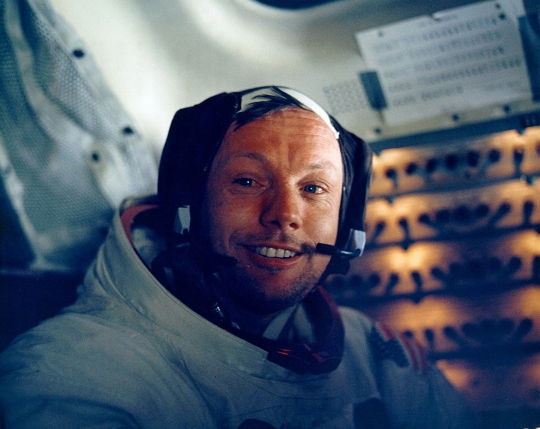
Image: This photograph of astronaut Neil A. Armstrong, Apollo 11 commander, was taken inside the Lunar Module (LM) while the LM rested on the lunar surface. Astronauts Armstrong and Edwin E. Aldrin Jr., lunar module pilot, had already completed their historic extravehicular activity (EVA) when this picture was made. Astronaut Michael Collins, command module pilot, remained with the Command and Service Modules (CSM) in lunar orbit while Armstrong and Aldrin explored the Moon’s surface. Credit: NASA.
“We believe our goal was a worthy goal. Connected with our two-word phrase ‘better than’ – the first tenet is quality and that applies to this 21 century, when we can be exceeding the results of the 20th century. Above all else is the quality of the people-in any organization the quality of its people is paramount. There is nothing more important than the quality of your teammates.
“Another tenet of ‘better than’ is leadership . . . The effective leader must be able to adapt to changing conditions.
“Sixty-seven years ago, during the second Great War, a flyer disappeared in his P-38 reconnaissance plane over the Mediterranean. The flyer was better known for his writing than his flying. He was the author of The Little Prince, Wind, Sand and Stars, and Night Flight. His name was Antoine de Saint-Exupery. A definition of leadership was captured in his novel, The Wisdom of the Sands:
“‘If you want to build a ship, don’t drum up the men to gather wood, divide the work, and give orders. Instead teach them to yearn for the vast and endless sea.’
“I was fortunate enough to be led by men who made me yearn for the vast and endless sea above the surface of the earth, and I am in their debt, and I am in your debt for allowing me to be with you today and for giving me a most valuable gift—your time. And I thank you very much.”
End of August 24, 2011 Speech in Sydney, Australia.
Over time Neil Armstrong evolved his speaking techniques and used more humor in his presentations, sometimes doing vocal imitations of the characters in his stories. Several times he imitated a Scottish accent—once when he was accepting an award in Edinburgh, Scotland.
In another story that fellow astronaut Jim Lovell enjoyed telling, Armstrong told the tale of two experimental mice who were in the final countdown to the launch of their suborbital flight. They were flying in a salvaged WWII V-2 rocket at the White Sands Rocket Range in New Mexico during the early days of life-in-space studies. Armstrong mimicked the high-pitched voices of the mice astronauts, strapped to their cockpit chairs and discussing the life-threatening dangers (explosions, parachutes not opening) they would soon face.
“I’m scared,” one said to the other. “Our rocket could explode at any time!”
The other mouse answered, “I still think it’s better than cancer research!”
In his speeches, Neil’s timing evolved and his attitude about speaking events became more positive. Space historian John M. Logsdon recognized this change and described it in his memorial tribute “A True Pioneer of the Science and Art of Flight,” shortly after Armstrong’s death in late August 2012:
“Although he was never comfortable with his status as an icon because of Apollo 11, as he got older he accepted that reality and came to enjoy sharing his experience of flying to a landing on the Moon with all who would listen.”

Lunar Landing Backup: Apollo’s Abort Guidance System
Al Jackson shares more memories of Apollo this morning in his account of a little known spacecraft component, the Abort Guidance System. A NASA historical document on computers aboard the Apollo spacecraft refers to the Abort Guidance System as “…probably the most obscure computing machine in the manned spaceflight program to date.” The AGS was a backup computer system offering the capability of aborting the mission if the Lunar Module’s primary guidance system failed during descent to the lunar surface, ascent or rendezvous.
The very invisibility of the system is in its way a tribute to the primary guidance and navigation systems, for while the AGS could abort a landing, it was never needed for that purpose. But NASA’s abort policy made its presence mandatory — an abort would be ordered if one additional system failure could potentially cause the loss of the crew. Thus a loss of either the primary guidance and navigation control system or the AGS would have caused an abort. Usefully, the AGS could verify navigation data when the Lunar Module was behind the Moon. Al was a subsystem expert on the AGS as part of his role as instructor on the Lunar Module Simulator. Here are his further thoughts.
by Al Jackson
The Apollo Spacecraft News Reference, compiled for the press, is 330 pages long and contains not a single note about the Lunar Module (LM) Abort Guidance System (AGS). There is, justifiably, a fair amount about the Primary Guidance, Navigation, and Control System (PGNCS). As it happened the Abort Guidance System was never used for a landing abort on any mission, even though it was on and in backup mode if it was needed.
The AGS existed due to a NASA requirement that at the Moon there could not be a single-point failure in the Guidance, Navigation and Control (GN&C) system for the LM. During the Saturn V launch the trajectory was controlled, for a while, by a computer with the exotic name of Instrument Unit. If the Instrument Unit failed, the crew could switch control of the Saturn to the Command Module’s computer; both these system had abort modes. Once inserted into Earth orbit, the Command Module (CM) Primary Guidance, Navigation, and Control System was programmed to do aborts from everywhere: from Earth orbit and after insertion onto the transfer orbit to the Moon.
The Abort Guidance System came into play when orbiting the Moon. When the LM and CM separated, if the LM primary failed before or during powered descent, the AGS could be used for establishing a rendezvous. The tricky abort situations were during descent: If the LM primary failed, then the AGS had to do an ‘ascent’ into a rendezvous orbit with the CM. The other possibility was failure of the LM primary before nominal ascent. Then the AGS would fly a nominal ascent and program insertion into a rendezvous orbit with the CM.
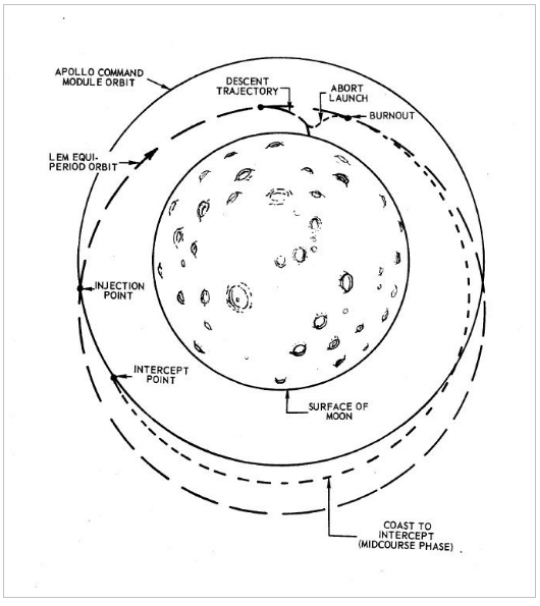
Image: Abort from descent.
On Apollo 13 a nominal translunar abort could not be done because the Service Module Motor was gone. The primary computer in the LM was used, though the procedure had to be created on the spot. Apollo 13 was flying the first non-free-return trajectory of the Apollo missions, so Lunar Orbit Insertion became Trans Earth Injection, so to speak. Once the LM Descent Engine was fired to put the LM on a trajectory that made an Earth re-entry, the AGS was used for most of the return to Earth, which included two mid-course burns to correct the trajectory. This was necessary because the Primary Guidance and Navigation System used too much water — it used gyros that needed cooling — and the LM’s supply of water was tight.
Here is as an obscure fact: A Descent Propulsion System firing with the LM docked to the Command Service Module was first performed in low Earth orbit during the Apollo 9 mission (March 1969) to test the Descent Propulsion System backup capability for the Service Propulsion System. (Apollo 9 was an Earth orbit mission, and with Apollo 7 the most forgotten of the Apollo flights.)
The AGS was a pioneer in that it was the first “strapped-down” guidance system. The system used sensors fixed to the LEM to determine motion, rather than a stable platform as in conventional inertial guidance systems. The entire system occupied only 3 cubic feet and consisted of three major components: (a) an Abort Electronic Assembly (AEA), which was the computer; (b) an Abort Sensor Assembly (ASA), which was the inertial sensor; and (c) a Data Entry and Display Assembly (DEDA), which was a simple version of the data entry keyboard on the primary system. (There is a nice compact technical description of the AGS in Wikipedia: https://en.wikipedia.org/wiki/Apollo_Abort_Guidance_System).
Buzz Aldrin got a doctorate from MIT with a thesis about manual orbital rendezvous of two spacecraft. The primary Guidance Navigation Computer did this perfectly and Buzz thought the AGS was almost as good. Buzz did practice a lot of rendezvous without navigation aids or the primary system or the AGS but he never had to do it in a flight, though I think itched to.
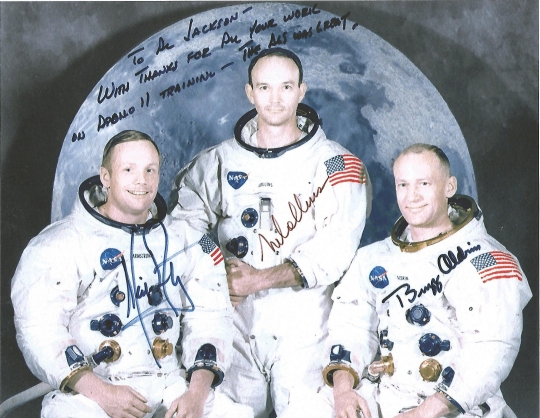
Image: Buzz put a personal message on this photo to me. I did not have much to do with the creation of the Abort Guidance System, AGS, but I was the prime AGS instructor in Houston at the Manned Space Craft Center 1967-1970. The message from Buzz reads: “To Al Jackson — With thanks for all your work on Apollo 11 training — the AGS was great.”
The AGS worked fine. I know of one funny story. When flying with the computers they had to have a ‘coordinate’ system to know where the spacecraft was and where to point it. Apollo had a platform called the Inertial Measurement Unit, designed by MIT, who were the super masters of doing inertial navigation. The IMU could be aligned from the ground or through star-sighting from the Command Module or the Lunar Module.
The AGS could be lined up with this coordinate system by communicating with the primary system. During Apollo 10, the AGS was aligned with the primary. However, after the ‘practice’ descent, ready to rendezvous with the Command Service Module, the Lunar Module had to stage, separating from the descent stage. This was done with the AGS in guidance control. Just prior to separation the LM did a wild spin. A mode switch was in the wrong setting, which led to Gene Cernan’s famous ‘Son of a Bitch’… All the technical details are in the mission report, beginning at 102:45:15 in the document: https://history.nasa.gov/afj/ap10fj/as10-day5-pt20.html.
[[PG: Cernan described the event this way: “I saw the lunar horizon go by about seven or eight times in ten seconds. That’s a hair-raising experience. That’s when I said, ‘Son of bitch, what the hell happened?'” Cernan and Tom Stafford jettisoned the LM’s Descent Stage and were quickly able to regain control, guiding the craft to rendezvous with the Command Module.]]
Another funny instance involves Bill Tindall. Howard Wilson Tindall, Jr. (February 20, 1925 – November 20, 1995) was an American aerospace engineer, NASA engineer and manager. He was an early expert in orbital mechanics and coordinated mission techniques during the Apollo program. In the words of flight director Gene Kranz, Tindall “was pretty much the architect for all of the techniques that we used to go down to the surface of the Moon.”
Bill was a sharp and amusing guy. Here is a note of his referring to how small the memory in the AGS was. In the memo, CSI refers to Co-elliptic Sequence Initiation, and CDH is Constant Delta Altitude, while a ‘G’ mission is a lunar landing and rendezvous mission. MPAD stands for Mission Planning and Analysis Division. Because the image may be hard to read online, I’ll also supply the main text, slightly truncated, after it.
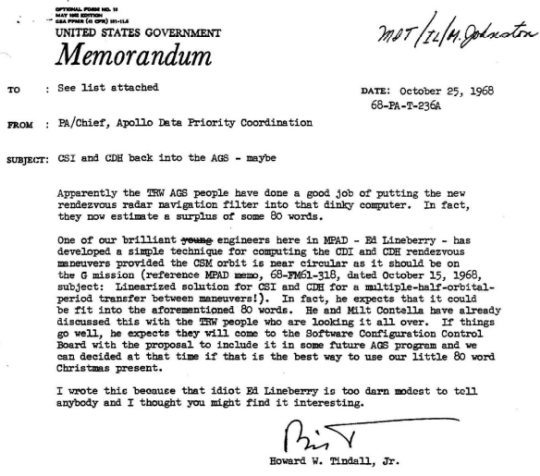
From: PA/Chief, Apollo Data Priority Coordination
Subject: CSI and CDH back into the AGS – maybe
Apparently the TRW AGS people have done a good job of putting the new rendezvous radar navigation filter into that dinky computer. In fact, they now estimate a surplus of some 80 words.
One of our brilliant young engineers here in MPAD — Ed Lineberry — has developed a simple technique for computing the CSI and CDH rendezvous maneuvers provided the CSM orbit is near circular as it should be on the G mission… In fact, he expects that it could be fit into the aforementioned 80 words. He and Milt Contella have already discussed this with the TRW people who are looking it all over. If things go well, he expects they will come to the Software Configuration Control Board with the proposal to include it in some future AGS program and we can decide at that time if that is the best way to use our little 80 word Christmas present.
I wrote this because that idiot Ed Lineberry is too darn modest to tell anybody and I thought you might find it interesting.
I remember when Pete Conrad and Alan Bean were in the Lunar Module Simulator cockpit talking about a failure of the primary guidance just before ascent, but the AGS was working. Then the ascent engine would not fire. One could access the ascent engine within the LM cockpit. Conrad said “I am gonna make sure we bring a screwdriver. We will take the ‘lid’ off the engine and hot wire it!”
The Abort Guidance System was tested on Apollo 9 and Apollo 10 (10 with the wrong mode switch settings). However, it was running in the background on all Apollo missions that used the LM. So Buzz is right about it working well.
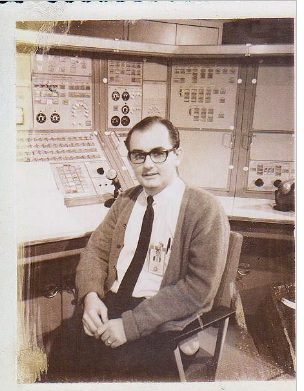
Here is a picture of me at the Lunar Module Simulator Instructors Console, AGS side, taken by a CBS crew for Cronkite’s 20th Century in 1970. The back of my head appeared for about 3 seconds on TV. 3 seconds! (Walter Cronkite did not travel with that film unit.)
And here is the LMS cockpit (crew cabin). Panel 6 is where the AGS keyboard and display are. Click to enlarge the image.
Many Apollo documents are at the following site, though I don’t think all MSC internal documents are there. https://www.ibiblio.org/apollo/Documents/

